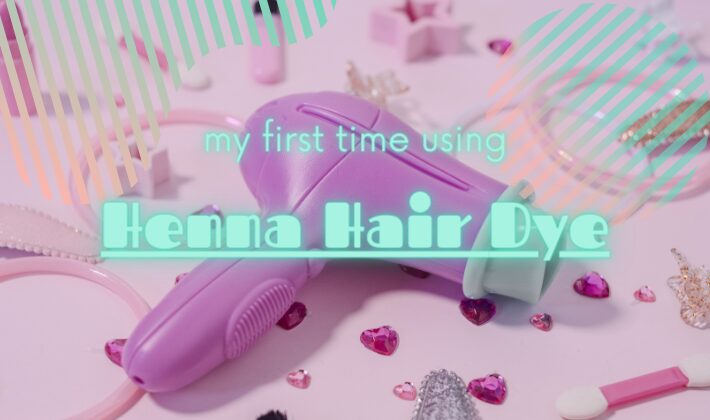When I was researching whether I could easily get my hair colored at salons in India, I stumbled upon “henna.”
I had experienced henna tattoos before, but I wondered what it would be like to use henna for hair coloring. So, I decided to give it a try! Just to give you some context, I don’t have much gray hair, but I’m concerned about damage and frizziness and wanted to add some color as well. That’s why I ventured into trying henna.
Today, I’d like to share my honest thoughts about my experience with henna dyeing and some unexpected incidents that occurred during the process.
Characteristics of the henna I used
Henna is 100% plant-based and known for its gentle coloring effect on “white hair,” providing hair with volume and shine in addition to color. If it’s 100% henna, it’s safe to leave on the hair and scalp for extended periods without causing damage, and it actually acts as a conditioning treatment. Compared to salon hair coloring, which can sometimes irritate the scalp and has a strong smell, henna feels like a completely different experience.
I bought Green Note’s Orange Brown henna from Amazon. Here are the features of Orange Brown henna:
- Gray hair coverage: Suitable for those with little to no gray hair, or up to 10-20% gray.
- Result: Gray hair turns into a shade of orange-brown, while black hair remains unchanged or slightly lighter.
- Application time: One hour or more.
- Conditioning effect: Increases volume, thickness, and shine. Suitable for damaged hair.
Preparing, Sequence, and Key Points to Remember When Dyeing Hair
The instructions included with the product were quite detailed regarding what to prepare: henna, hot water, a bowl, a whisk, gloves (included in the package), a towel, plastic wrap, a brush, chopsticks, newspaper, and a shower cap. Here’s the step-by-step process they outlined:
- Preparing the Henna Paste: Use a whisk to mix henna powder with hot water until it reaches a consistency similar to ketchup.
- Applying to Dry Hair: Use chopsticks to section your dry hair and apply the paste with a brush. For covering gray roots, focus on those areas. Note that for orange-toned henna or colorless henna, it’s acceptable to massage the paste in with your hands for overall coverage.
- Wrapping: Once applied, wrap your entire head with plastic wrap.
- Additional Covering: Wrap a towel over the plastic wrap and wear a shower cap.
- Waiting Period: Leave the henna on for the specified duration.
- Rinsing: Rinse out the henna thoroughly with shampoo.
Depending on whether you’re doing a full coloring or touch-up, the required items may vary. In my case, I improvised with items I had at home and skipped using the shower cap, newspaper, chopsticks, and brush (laughs).
The product’s website, Green Note, provides thorough information on preparation, usage amounts, application time, and technique.
I wasn’t entirely confident with just the instructions, so I turned to YouTube to learn how to dye with henna. Here are three key points I picked up:
Importance of Smoothness After Mixing Henna with Water
Every YouTube video emphasized the importance of achieving a smooth consistency after mixing henna with water. It was recommended to make it as smooth as ketchup because a watery consistency might not dye well. Following this advice, I made sure to mix it to a smooth texture before application.
Significance of Quantity After Mixing Henna with Water
The amount of henna used after mixing with water is crucial and varies depending on whether you’re dyeing the entire hair or just sections. Since I wanted to dye my whole head and it was my first time trying, and my natural hair is black, which doesn’t usually dye easily, I used the entire 100 grams. Some YouTube sources mentioned it’s okay to use all of it for the first few times until the color sets, so I followed that advice.
Duration After Applying Henna
The amount of henna used after mixing with water is crucial and varies depending on whether you’re dyeing the entire hair or just sections. Since I wanted to dye my whole head and it was my first time trying, and my natural hair is black, which doesn’t usually dye easily, I used the entire 100 grams. Some YouTube sources mentioned it’s okay to use all of it for the first few times until the color sets, so I followed that advice.
These were the crucial points I learned and applied from YouTube to ensure my henna dyeing process went smoothly.
Impressions After Applying Henna & Unexpected Incidents
For partial coloring, it seems you need to meticulously and neatly apply henna to the roots using a brush and chopsticks. In my case, since I was dyeing my entire head, I just piled all the henna on with my gloved hands (laughs).
Well, it was quite a task! My hair got tangled, oh so tangled!! I managed to massage the henna all over my hair somehow, wrapped it up, and called it done! It probably took about 3-4 minutes to finish applying. Making and applying the henna was surprisingly easy up to that point.
Next comes the approximately 3 hours (my own arbitrary goal) of leaving it on. Unlike at a salon where you’re stuck in a chair, at home I could do various things like surf the net, clean the floor, have lunch, and tidy up the bathroom. The time flew by. During those hours, I encountered several mishaps, so I’ll share them for your entertainment (laughs).
Some things can easily be cleaned off if henna gets on them, while others are harder to remove.
When I applied henna in the bath, it splattered everywhere. (I think it’s just because I’m not very skilled at applying it.)
Things that henna easily comes off of include plastic, bathroom tiles, sinks, black clothes, and towels. It also comes off skin within a day.
Things that henna doesn’t easily come off of include rubber seals (like those in baths), white clothing, towels, and fabrics. If henna gets on something white, it tends to leave a yellowish stain even after washing, similar to curry stains.
As time passed, it started dripping down in little drops.
As the 3-hour mark approached, henna started dripping from my head—drip, drip, drip. Does henna come off more when it gets warm? Was my guard down? I was pondering these questions when henna started dripping endlessly. “I can’t leave it like this any longer!” So, right at the 3-hour mark, I rushed into the bathroom and shampooed it out.
Even after four shampoos, brown water kept flowing from my hair.
The instructions only said to “shampoo,” so without thinking much, I shampooed my hair. However, brown water kept flowing endlessly from my hair (laughs). After shampooing four times, I gave up and wondered, “How many times do I need to shampoo?” After showering, I searched again and found out that it’s okay not to shampoo after using henna. I didn’t need to shampoo so many times, but I was curious, so I shampooed four times (laughs). It seems this is normal, so please don’t worry.
I was cautious, but after drying my hair, there was no color transfer to towels or pillows.
The smell isn’t strong; it’s like the scent of tea.
I’m somewhat sensitive to smells, but I didn’t dislike the scent of henna. It smells like tea. Even after shampooing, my hair still has a faint tea-like scent (laughs).
The Outcome of My First Henna Coloring Experience
I had been coloring my hair and then switched to black dye. Since I hardly had any gray hair, I figured henna wouldn’t do much and thought of it more as a treatment. With this mindset, I decided to give henna a try.
To my surprise, when I opened it up, my hair had actually taken on quite a bit of color. I was amazed. There was a mix of red with the black, so indoors it looked pinkish, but outdoors it was a solid reddish-brown.
I was extremely satisfied with the color results, but as for the treatment effect? Honestly, it’s a bit of a mystery. It didn’t make my hair silky smooth. If anything, it felt a bit stiff. However, my frizzy hair seemed tamer, which I appreciate. Since one application might not be enough for a treatment effect, I’m eager to give it a few more tries.
Thank you for joining me on my first henna coloring challenge today.









